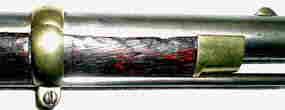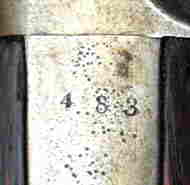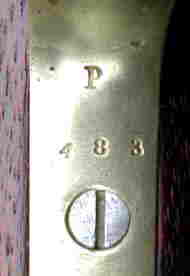|
|
||||
|
(3rd Type Justice)
|
||||

|
||||
|
|
||||
|
|
||||
|
Among all the types of Civil War U.S. government contracted rifled
muskets, the most confusing as to a standard make up has to be the
weapons that P. S. Justice furnished in late 1861. In the autumn of
1861, Phillip S. Justice of Philadelphia delivered to the Ordnance
Department 2,174 rifled muskets. The first of these were fabricated
from the parts of several muskets. He utilized Model 1861 lock and
trigger assemblies, Model 1840 or 1842 barrel bands and springs, Enfield
type brass stock tips, and newly made stocks similar to the Model
1816, without comb. The black walnut stocks were sometimes made with
green unseasoned wood. They had bolster type converted barrels fitted
with a long-range rear sight and rifled in .69 caliber with 3 broad
bands and very shallow grooves. A "tulip-head" ramrod similar to the
Model 1863 was utilized with this model.
|
||||
|
A second variation was made without barrel bands or sling swivel.
It had all brass furniture, a matchbox and a different type of 'tulip-head'
ramrod held under the stock by two brass thimbles. It featured an
unusual, configured trigger guard with a double curve profile. They
are found with long-range rear sights or a fixed "V" notch type dovetailed
into the barrel. It was .69 caliber rifled with 3 shallow grooves.
The stocks were black walnut and rather crude having been made from
unseasoned wood. It is considered to have been the most inferior of
all arms delivered to the U.S. Ordnance Department during the Civil
War.
|
||||

|
||||
|
|
||||
|
|
||||
|
The third type, as pictured here, was made entirely as a new arm.
It did not, supposedly, utilize any old parts. It is basically a well
made attractive arm. It does not conform completely to Riley's description
in "United States Military Small Arms, 1816 - 1865", nor exactly to
Flayderman's description. It comes nearer to Bill Edwards description
in "Civil War Guns." Since I have this gun myself and have carefully
measured and inspected it in detail as well as by photograph, I will
certify the following descriptions and measurements to be exact as
they apply to this particular individual arm. I will further certify
that this rifled musket is, with the possible exception of the ramrod,
entirely original. However, I believe the ramrod is good also but,
since it is removable, I can not attest to it being original to the
arm.
|
||||
|
The overall measurement of this arm is 55". The barrel is 39" and
the stock wood is 52" with a 9-1/8" low comb. The brass, Enfield like
nose cap is 7/8" long. The oval brass top barrel band is ½"
in width. The middle and upper oval brass barrel bands are 5/16" wide.
A sling swivel is in place on the middle barrel band. The lower sling
swivel is on the forward arm of the trigger guard knuckle bow. The
8" long brass trigger guard bow and tang are of one piece construction
with the front termination being square and the rear slightly curved.
The brass, Sharp's like patch box and the brass butt plate are typical
of Justice type arms.
|
||||
|
||||

Bottom View of Brass Trigger Guard |
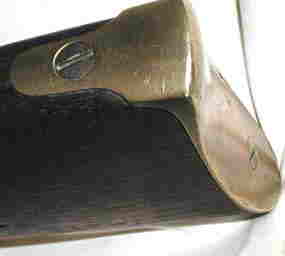
Oblique View of Brass Butt Plate |
|||

Stock Comb and Brass Patch Box
|
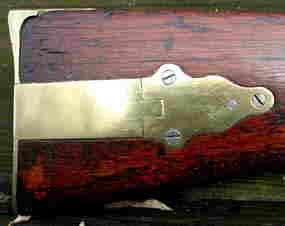
Close Up of Brass Patch Box
|
|||
|
A bayonet stud, ¼" long by 3/16" wide by 1/16" high, is located
on the top of the barrel 1-1/8'' back from the front of the barrel.
The front of the 3/16" high, brass blade front sight is located 1-5/8"
back from the rear of the bayonet lug or 3-1/16" from the muzzle.
The long range, side protected rear sight is graduated from 100 to
400 yards. It is secured to the barrel by a real screw, not just a
screw head that has been soldered on, as in the case of earlier models.
|
||||
 |
 |
|||
|
|
||||
|
||||
|
The top of the barrel is marked "P. S. JUSTICE/PHILA" in 2 lines just
forward of the nipple recess. The barrel shape, at the breech section
where the name has been struck, is somewhat semi-octagonal in form.
The serial number "483" is stamped at the top of the barrel tang.
The same number, "483", is on the rear tang of the trigger guard under
a "P".
|
||||
|
||||
|
|
||||
|
There are numerous variations in lock plate marking found on Justice's
arms. However no one mentions markings on the ram rods. Here is the
lock plate on the rifled musket pictured. It is marked with a eagle
and shield stamping over "U S" to the left of "P.S. JUSTICE" over
"PH(ILADA)". The ram rod has the Roman numeral marking of "X VI" (16?),
2" back from the tip of the ram rod*.
|
||||
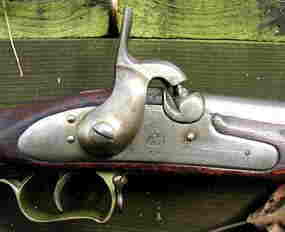
View of Lock Plate, Hammer and Trigger Guard |
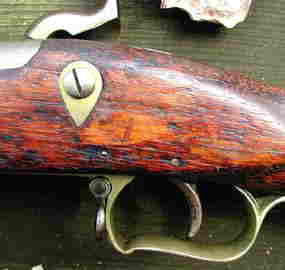
View of Hammer Screw on Reverse Stock
|
|||
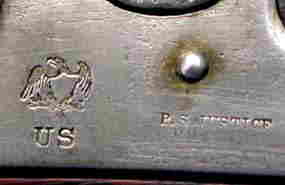
Close up of Lock Plate Marking
|
||||

Ram Rod Marking - X VI" * The ram rod when seated is ¾" down from being even with the barrel mouth.
|
||||
|
The .69? caliber barrel is rifled with 3 broad grooves and lands.
A .69 caliber minie ball is a little bit loose at the barrel opening.
It may however expand sufficiently to grip the rifling when fired.
Following are pictures of the front of the barrel showing the lands
and grooves and with a bore gauge inserted. I would say that it measures
closer to .72 caliber than .69. What do you think?
|
||||
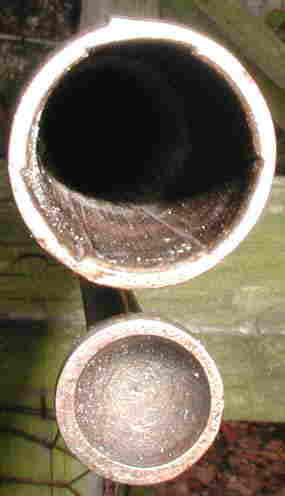
Front of Muzzle Shows 3 Lands and 3 Grooves
|

Looks like .73 cal. here (Groove to Groove)
|
|||
 |
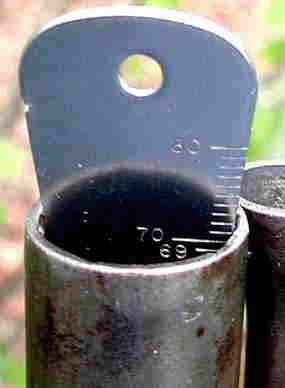 |
|||
|
|
||||
|
|
||||
|
Well, I'm out of both pictures and words (almost). Say what you will
about Phillip S. Justice, he delivered on his contract in a few short
months in 1861. What he delivered was better than his sample arms.
The government knew what they were getting and in most cases got better
than they bargained for. P. S. Justice was vilified in some quarters
but he delivered when his country needed it most. He suffered large
losses in both personal and financial standings. Give justice to Justice..........he
delivered what he promised .....Fake screw heads and all.
|
||||
|
Credit for some material and all inspiration for this posting should
go to P.S. Justice and the fine rifle musket he made for me
and..........to Robert M. Reilly and his book "U.S. SMALL ARMS
1816 - 1865" and to........... William B. Edwards for his great
book "CIVIL WAR GUNS" and to, of course, the great Norm Flayderman
for his seemingly endless series of "FLAYDERMAN'S GUIDE(S) TO ANTIQUE
AMERICAN FIREARMS.... AND THEIR VALUES."
|
||||
| Dave
Radcliffe
|
||||


